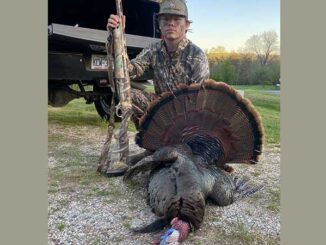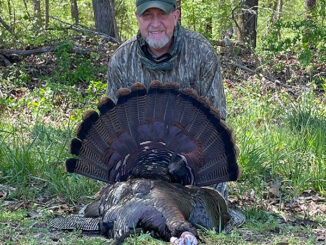
Tillery’s schooling bass are a big draw in the fall, but there’s more that makes the lake great.
As the leaves fall at Morrow Mountain State Park, bass fishing at adjacent Lake Tillery hits its peak. Autumn has long been a favorite time for many anglers to fish the 5,000-acre reservoir near Albemarle.
Why autumn? There’s an easy answer.
Tillery’s largemouths are concentrated in major creeks, smashing into schools of threadfin shad. As the lake cools, the shad follow the warm-water gradient into pockets where the water is warmer than in the main channel.
Put baitfish, bass and fishermen in restricted areas like pockets, and something is bound to give. Usually, it’s the bass.
Maynard Edwards of Lexington, who operates Yadkin Lakes Guide Service, said he looks in the backs of Tillery’s creeks when the water starts to cool.
“Usually, there’s lots of schooling activity in November at Tillery. I go to the backs of the creeks and look for action — particularly around the edges,” he said. “You know the creek where the seafood restaurant is? That’s Cedar Creek. Both arms of that creek are hot spots in November. Fish the little cuts. Usually I fish fairly shallow there. I throw a Pop-R or a floating worm to the edge of the grass.”
Your favorite topwater bait will probably work just as well. If fish don’t jump on your topwater — even though they appear to be feeding near the surface, move to a jerkbait like a Rogue or Swim ’n Image. A 2- or 3-inch tube on a quarter-ounce jighead is another good approach for largemouth that are shadowing schools of shad. With a good spinning outfit, you can cast a country mile — which may be necessary since bass often break the surface a good distance from your boat.
Rig the tube with the jighead inside so it falls more erratically. White, pearl or blue are good tube colors.
Vibrating crankbaits such as Rat-L-Traps or Spots, and blade baits such as Sonics or Silver Buddies, are other good choices, and can also be cast a long way. A Little George tailspinner is another option.
Water willow, an aquatic grass, forms vast beds in Cedar Creek and all over Tillery, particularly on main-lake points and the shorelines of major creeks. As November advances, the weeds die. Early in the month, they are dense and green, and bass use them for cover and to ambush the smaller fish that also use the weeds for shelter. Be sure to toss a floating worm to the inside edge of the weeds.
Drew Montgomery, a Lake Norman guide who fishes Lake Tillery from time-to-time, also recommended paying attention to the grass beds. “Fish the grassy points. Between the NC 73 bridge and the dam, there are a number of them. I sure like the Spook!” he said.
Spooks or other topwaters may also be used as one lure or in tandem with another. A small spoon with a feather tail can be rigged ahead of or behind a bigger topwater bait. A monofilament leader a foot or so long is tied between the topwater and the spoon. If the spoon is ahead of the topwater, many fishermen contend that bass see the spoon as a small fish escaping from a larger one. In any event, it works, whether the spoon is ahead of or behind the topwater. And a heavy topwater lets an angler reach bass which come to the surface a distance from the boat. Certainly, the small spoon creates flash and is of a size which suggests threadfin shad. It works great when largemouth are herding shad in shallow water.
“If I can’t catch fish with the topwater, I hit the edges of the weeds with a jig-and-pig,” Montgomery said. “The fish are there. You just got to get them to hit.”
Two spots where bass tend to herd shad and feed heavily in the fall are in Cedar Creek and Lower Richland Creek.
At Cedar Creek, Edwards said, “There’s a kind of pond back there, under the bridge. That’s usually a good spot in fall. Largemouth follow the shad back into the shallow water in that pond.
“Across the lake (in Lower Richland), there’s another good November spot, back under the bridge. You have to go through a narrow area.”
The upper end of Richland Creek, which enters the main lake just upstream from Lower Richland, and Wood Run are also productive areas in the fall.
Tillery is usually quite clear, particularly in the fall, according to Edwards. Often, fishermen can see schools of shad below the surface, and even if fish aren’t breaking the surface, the shad can be seen occasionally scattering in front of a feeding bass.
Jacobs Creek is another top fall area, but for a different reason. The back of the creek is filled with stumps, and when bass aren’t busting schools of shad, they’re usually holding near the stumps. A small buzzbait or Texas-rigged worm cast around visible stumps should draw a strike.
If you can’t find bass busting shad, Edwards recommended rocky points.
“If they’re not schooling, target rocks, particularly the rocky points back in the creeks,” he said. “Try small crankbaits. Tillery largemouth, for some reason, like smaller lures than the bass on other Yadkin River lakes. I like a chartreuse Flat A.” A Fat Free Fingerling or Model A Bomber are also productive baits.
Montgomery said that current makes a big difference in where you should fish. If water is being drawn through the dam, fish the upper end, upstream from Dutch John Creek, he said.
“Fish the current at the upper end of the lake. When this works, you’ll need good batteries on your trolling motor,” he said. “Throw a jig-and-pig near the rocks.”
A heavy jig is needed, as the current can be pretty fast. Try a black/blue jig with a comparable trailer or a brown jig with a blue trailer. When the current lets up, the action will stop.
Fishermen shouldn’t expect to catch trophy bass at Tillery on a regular basis, but 4- and 5-pound fish aren’t uncommon.
“Tillery is not known for big fish, but there are lots of them,” Edwards said.
Docking procedures
No discussion of Lake Tillery would be complete without mentioning piers and docks. They abound at Tillery, just about everywhere except around Morrow Mountain State Park.
Particularly productive piers are from the NC 73 bridge on the west side of the lake downstream for about a mile, and on the east side of the lake, upstream from the bridge the same distance. The area around Norwood on the west side of the lake, only a mile or so above the dam, also holds productive piers.
As November progresses, largemouth move deeper and deeper on the piers. Some of the piers extend into fairly deep water. Keep an eye on the depth finder and fish near the deep end of the piers.
As the water cools, bass metabolism slows. Slower and more deliberate approaches are required. A jerkbait fished slowly around piers is a winner, in chrome/blue or chrome/black. Suspending jerkbaits like Rogues and Long A’s are preferred. Another weapon around piers is the jig-and-pig in black/green, black/blue and brown.
A welcome guest
Lake Tillery, as is the case with the other impoundments on the Yadkin-Pee Dee River chain, is managed with a 5-fish daily creel limit and a 14-inch size minimum for largemouth bass.
One of the lake’s main tributaries is the Uwharrie River, which joins the Yadkin River in Tillery’s upper reaches to form the Pee Dee. The Uwharrie is home to smallmouth bass, and every now and then, a smallmouth shows up in the creel of a Lake Tillery
fisherman.
The 5-fish, 14-inch limits apply to smallmouth bass also.
DESTINATION INFORMATION
HOW TO GET THERE — Lake Tillery is a half-dozen or so miles east of Albemarle. It forms much of the border between Stanly and Rockingham counties. NC 24/27 and NC 73 cross east-west at mid-lake. The N.C. Wildlife Resources Commission has public access areas at Swift Island on the east end of the NC 24/27/73 bridge, another in Norwood and at Morrow Mountain State Park opposite the mouth of the Uwharrie River.
BEST TACKLE/TECHNIQUES — Search the backs of major creeks for bass feeding on schools of shad, breaking the surface. Topwater plugs and tube jigs are deadly. If no surface activity is present, fish shallow stumps with a worm or buzzbait, or fish deep docks with a jig or jerkbait. Pay attention to grassbeds and fish them with a floating worm or jig.
ACCOMMODATIONS — Stanly Chamber of Commerce, 704-982-8116 or www.stanlychamber.org.
GUIDES/FISHING INFO — Maynard Edwards, Yadkin Lakes Guide Service, 336-249-6782; Kevin Chandler, All-American Guide Service, 704-463-7265; Joe’s Bait & Tackle, Albemarle, 704-982-871ll6; Min-O-Pon, 704-982-5566. Also, see GUIDES & CHARTERS in classifieds.
MAPS — The Lake Store, www.TheLakeStore.com; NoMoon Publishing Co., www.nomoonpub.com, The Map Shop, Charlotte, 704-523-6277.









Be the first to comment